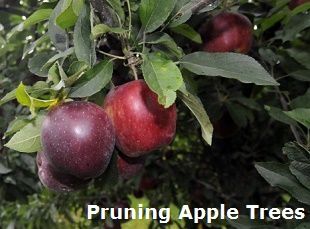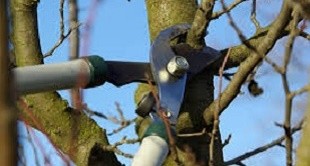RULES FOR PRUNING APPLE TREES: This is a simple guide to pruning apple trees.
It highlights the importance and simplicity of controlling rampant re-growth throughout the orchard. By doing so, you can avoid the habitual mistake of heavy-handed cutting.
As a rule, a healthy apple tree in England is one with a glossy dome outline. It should have strong, well-balanced branches bursting with rosy red and green fruit.
Of course, they do not produce sweet pomaceous apples all year long. But, a fruit garden should resemble a flourishing lustrous woody plant towards the end of British summer time.
So what if the crop is looking a little sparse on productivity with distorted leaves? Or even worse, showing signs of fungal infection. The culprit for unbalanced foliage and disappointing fruit returns, is neglect or over pruning – more often than not.
Equipment for Pruning Apple Trees
Knowing how to prune apple trees in England also means having the proper pruning equipment. You cannot hope to create a sturdy arboreal framework using blunt secateurs and a rusty old wood saw.
We base this simple list of required equipment for pruning apple trees on cutting branches which are no more than three inches in diameter.
You may need a professional tree surgeon with a powerful chainsaw to prune anything larger. Specialist pruning tools include:
- A piece of chalk for marking off and a bucket for any mouldy fruit.
- Sharp garden secateurs, loppers, and a folding pruning saw.
- Sturdy ladders and some rope to secure the ladder to the tree.
1. Preparing to Prune the Tree
If you are preparing to prune the most popular rootstock specimens for apple trees (MM106 semi-dwarfing 3 – 4 meters high), you will need a ladder.
Always lean your ladder securely and fix it into the core of the tree dome. The ladder should be propped and tied off so that it will not wobble against any healthy branches close to where you are cutting.
Securing Ladders: Loop the rope around the rung closest to a sturdy branch (twice) and then tie it to the same branch using a granny knot.
Ideally you are trying to remove unproductive upright stems in the center of the bush (epicormic growth). Be sure to get a good look up into the woody section before you start to prune. Note, or mark off, any dead, or diseased boughs in preparation of their removal.
Note: As a rule, the best time of year for restorative pruning of apple trees is during the winter time. But, it is often easier to differentiate healthy leaves from poor crop during the growing season. A gentle trimming of heavy foliage also reduces too much vigorous productivity.
 Procedures for Pruning Apple Trees
Procedures for Pruning Apple Trees
You will need less effort if you work above your cutting area. Cut back in small sections, rather than man-handling large branches
Often, the best technique is to begin by sawing bark on the underside before cutting down from above.
Opening up the middle of a tree encourages air to move unhindered through the fruit and foliage. It also reduces the risk black blotchy fruit from apple tree fungal infections such as scab and mildew.
Winter Pruning Apple Trees
The best time to prune fruit trees, and certainly the majority of apple and pear trees, is during the cold northern European winter time (November to onset of March).
As a rule, winter pruning apple trees ensures a productive cycle of fruiting wood. It also reduces congestion of old boughs and branches. The simple aim is to form a framework of four or five main boughs that resemble a goblet. It should look something like the shape of a chalice with a narrow stem.
3. Cutting Apple Tree Branches
Unwanted boughs need cutting in the correct manner. Each final cut should always be alongside the ‘branch collar’.
 Branch collars are raised rings of bark where branches either join the trunk or intersect with a different branch. You need to cut boughs correctly because these nodes contain concentrations of growth cells.
Branch collars are raised rings of bark where branches either join the trunk or intersect with a different branch. You need to cut boughs correctly because these nodes contain concentrations of growth cells.
This is where bark regrowth happens the fastest. So, cutting at this point helps to seal the cut and reduce the need for anti-fungal tree paints.
When you start cutting apple tree branches and boughs, begin with any that are rubbing, congested, or crossing. Be sure to remove diseased or weak twigs, and dead spurs. Strong shoots which are more than 15 centimeters long (6 inches) and growing in the center, or towards the middle, should get lopped off.
Note: Cutting these branches will improve light levels and air flow through the bush.
4. Using Gardening Secateurs
Is there a golden rule of pruning apple trees? Using sharp gardening secateurs, efficient loppers, and a high quality pruning saw, has to the secret. Shabby pruning cuts, and a few muscle strains, is all you are likely to gain by using blunt gardeners’ tools.
So the next move is to take those sharp gardening secateurs and deal with all those whippy uprights and weakened epicormic wands. You should completely cut away those which sprout out from the main trunk.
Tip: You might find a gap high up in the canopy, perhaps because of a broken branch. If so, leave a few stronger stems to spread into the gap but go ahead and thin any which are growing near to the branch ends.
5. Finish Off by Collecting Bad Apples
There is one more task to complete before your apple tree pruning work is all done. Take a good look into the high canopy and check for any brown fruits. Mouldy apples are most likely to produce brown rot fungus or canker.
Chop them off and collect any that have fallen off the tree. The best place to discard a bucket full rotting apples is to bury them deep inside your compost corner.
There you go – you have completed the five easy steps how to prune apple trees in England. You may have been busy following all the rules of pruning in a commercial fruit orchard or trimming your dwarf Bramleys in the backyard. Either way, you should now be admiring an open goblet of branches.
The trunk should be clear of congested whippy shoots with shining light levels. There should be good air flow circulating through the top boughs of the apple tree.

